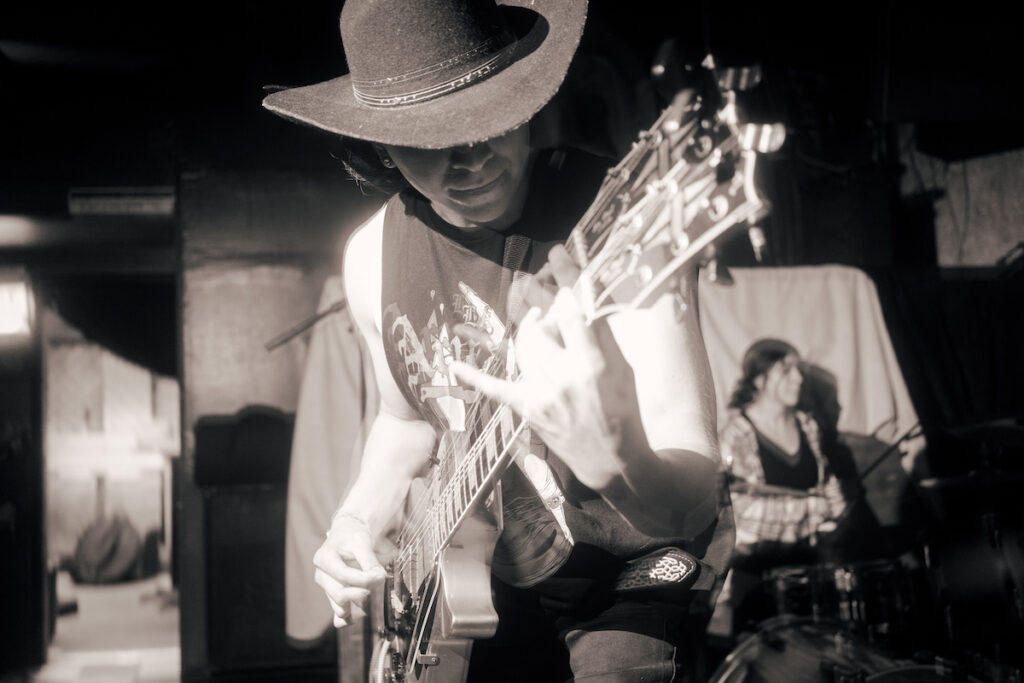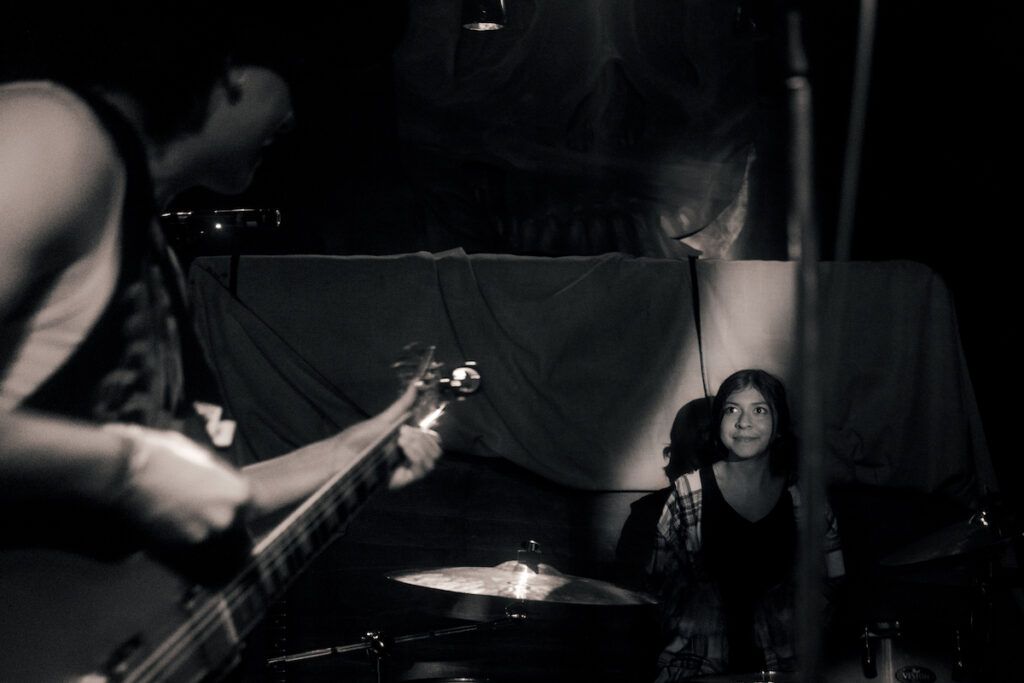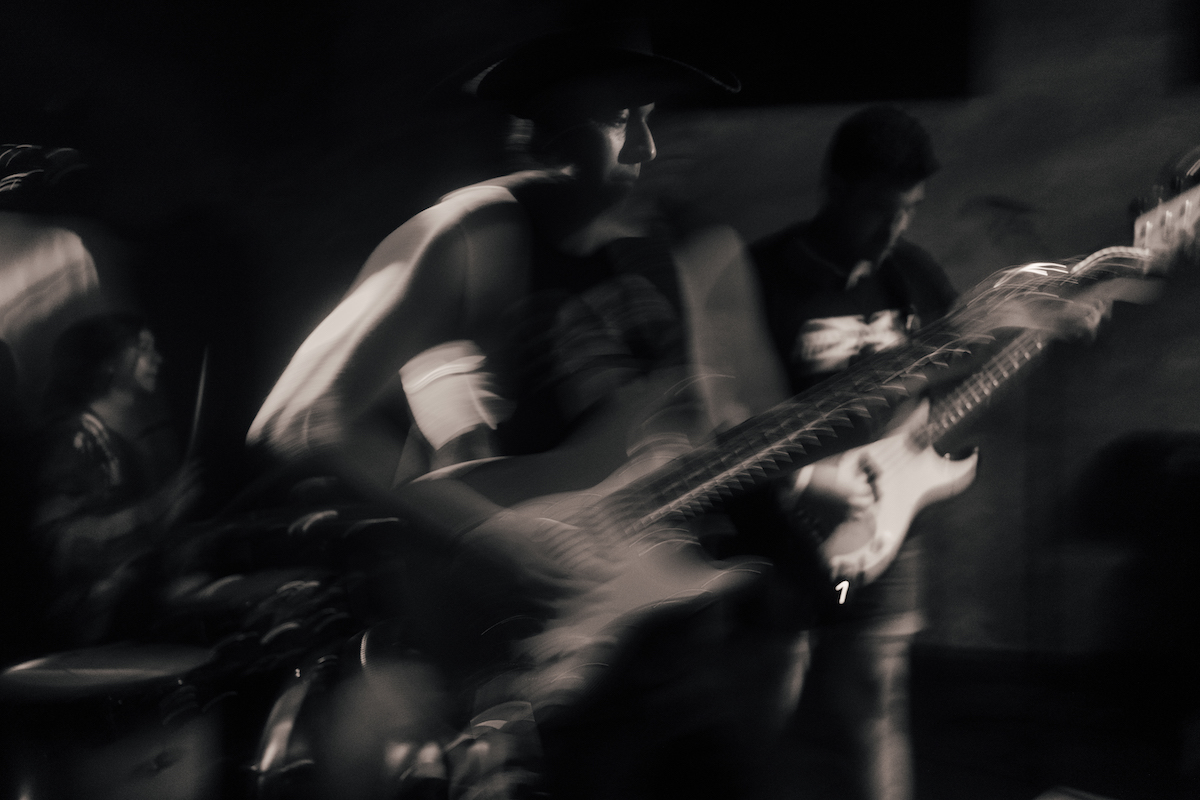Cameras and lights flashed across the room as a man took off his black sombrero, hopped on stage, and climbed up on a speaker about his height. The man, Francisco García, goes by Pancho and is the lead singer of LOS SKIN. Pancho leapt off and hurled himself into the crowd. The people below braced themselves to catch the man who, moments before, performed with his sister Stacy García.
LOS SKIN is a brother-sister Chicana/o Punk duo based in Pilsen. They identify as Chicana/o, an ethnic and political identity that recognizes the unique cultural upbringing of many Mexican Americans—perfectly synergizing with punk music’s politicized and countercultural roots. One only has to see them perform live to experience this.
Songs on their sets switch from fast-hitting guitar riffs and impactful drums to psychedelic cumbia-inspired guitar work and danceable drum beats. Their event “Vaqueros Y Rockeros” (cowboys and rockers) last summer at the Subterranean on the North Side created a space for both cultures to meet. As the name says, this was a show for cowboys, rockers, and everything in between.
DJ Flores Negras, a friend of the band, invited them to fill in for her set, Cumbia Y Los Goths. LOS SKIN jumped at the opportunity. Weeks of preparation went into planning “Vaqueros y Rockeros.” They contacted the venue, put a lineup together, got the word out, and distributed flyers throughout the city.

On the day of the event, Pancho calmed his nerves by going to work at his parent’s retail store. “If I were to stay home, I would be pacing around like, ‘fuck fuck fuck,’” he said. After clocking out, Pancho headed over to his mom’s house to pick up Stacy and her drums. They met Alex, their new bassist and the lead of Nikko Blue, at their practice space. Gathering the rest of their equipment, they headed over to the venue.
Arriving early and stepping out of an older white minivan with instruments in hand, they were greeted by the sight of people dressed in an eclectic mix of combat boots, botas, sombreros, Dickies pants, and metal band t-shirts.
One of the guitars LOS SKIN had brought, a vintage Les Paul, was gifted to Pancho by their dad, who had also been in a band in his youth. Pancho said, “They did cumbias, almost like Los Bukis, and covers too.” Pancho had been playing guitar for four years using his dad’s Les Pual to get that heavy tone he loves.
Stacy, meanwhile, had only been playing for over a year but quickly took to the drums. A girl drummer in a music genre historically dominated by men, Stacy was thirteen at the time of “Vaqueros Y Rockeros”.
Someone else was originally going to play drums for LOS SKIN, but he became ill the day of an event. Since Stacy was already taking drum lessons, she was a perfect last-minute substitution. Pancho said, “I made her jam, and it sounded good. We played a show, and it went really well, and we just kept practicing {together} from there.”
She is younger than the age requirement of many venues, but still hammers away drum beats when performing.
The line was winding around the corner. Passerbys looked at the group of concertgoers with confusion and curiosity. It was a large turnout, and everyone was here—everyone except the sound guy. Through a miscommunication, the person in charge of the show’s sound setup had gotten the wrong date. The bands were all there, and the speakers were in place, but no one could finish the sound check. Their instruments just lay there half set up.
One of the employees decided to lend his PA system for the event. “The guy hooked it up and was like, ‘This gonna be like super DIY.’ But we’re all used to that,” Pancho said.
LOS SKIN was up, starting the night fast and heavy with their song “Skin” and keeping that pace throughout the set until slowing things down for their last two songs, “Calavera” and “Si un dia me voy”.
“We’re heavy as hell, and then just like that, we’re singing about our hearts breaking,” he said.
The Weekly spoke with the Garcías. The interview has been edited for length and clarity.
How did you feel when you showed up and saw a line of people in vaquero hats?
Pancho: It was dope . . . being able to express [yourself] with other people who are aware of the culture. Being able to be a vaquero and rockero. You’re both, you know? So it’s cool to see all that in one room where people get down to rock music and norteñas. We don’t see that sometimes, but we were able to show that this is who we are.
How did your family react when you started a punk band?
It’s funny; they were like, “Oh, you guys play music.” They thought we would sound bad, but then one of my uncles checked us out. He came to my house because we used to practice at my dad’s barn. We had a show there, and my uncle came and said, “Let me hear something.” And we played, and he said, “Whoa, you guys actually sound good!” Some of my cousins were like, “Low key, I thought you were gonna sound like ass, but it’s actually really good.”
So it just happened like that? It wasn’t planned out?
Yeah. I would have never thought Stacy and I would be playing music together. I wouldn’t expect us to be good in a humble way. We’re able to make music, and I would never expect that.
I know you guys label yourselves a Chicana/o punk band. What differentiates you from regular punk?
Well, being Chicana/o. It’s like we’re Mexican, but we’re first generation too. I never really looked at it as something, but now it’s like an identity for me. Both my parents were born in Mexico. And it’s amazing seeing where my parents come from (Guanajuato and Morelos) and them giving us the opportunity to do what they couldn’t. So that’s why I use the name Chicana/o.
We came up with the name LOS SKIN because of the color of our skin. It’s in our blood. We’re Latino; we’re Mexican. You don’t see a brother-sister band, especially a Mexican one, often. People can relate to some of the struggles that we went through.
We do have a culture, you know? It’s incredible we can express ourselves and not hide. To be able to share what we feel and [people] being able to relate.
Is this identity something you’ve recently discovered?
I feel like it’s always been there, but it’s something I recently got into. I feel like I wasn’t really able to express myself, and now I’m able to with Chicana/o. I’m a proud Chicana/o. It’s just how I feel, and I can finally express that.
Growing up, I went from a diverse school to an all-white one. I felt almost embarrassed about how we lived because our culture was so different from theirs. I was constantly worried that people were looking at me weirdly. Good thing I had great friends that helped me embrace myself and never judged me based on how I look or how my family lives.
I still didn’t have that connection with other Latinos and Mexicans because I never spoke Spanish with someone my age. You know, an actual conversation. It was always with my mom and other family members. When I was eighteen, I was like, “Oh, I really wanna get back into my roots.” I really wanted to see my culture. So I got into it more, little by little. Now I feel like I’m fully discovering my true Chicana/o Mexican self.

What about you, Stacy?
Stacy: I don’t know. It’s cool being in the Mexican family, but at the same time, it gets weird.
Pancho: What’s weird about it?
Stacy: Sometimes you want to be like other people. But at the same time, you like your culture. But then it’s weird because you don’t know what other people think about it. So you don’t know where to go.
Pancho: The way I see it now, people think you have to prove something that you don’t. What makes you Mexican is being you, being who you are . . . embracing your culture and all this stuff living in your blood. You don’t have to prove anything. You don’t have to be more Mexican than the other person. Just be yourself.
Do you have any musical inspirations? What do you listen to for inspiration or to replicate in your music?
Pancho: Oh yeah, definitely. I like hardcore, metal, experimental stuff, and psychedelic music. For example, l really like Pink Floyd or Tame Impala. There are some stoner metal bands that I get inspiration from too. And then on the Latin side, I realized I really like cumbias because that inspired me to play it too. And then Calfines is cool. I was like, oh I want to start singing Spanish. I want to add more cumbia to our music.
Stacy: I mostly like rock and punk. Like System of a Down and Falling in Reverse. Sometimes indie music.
Pancho: When we first started playing, “I was like, what kind of music do you want to play, Stacy?” I thought she wanted to play something soft or something. She was like, no, some punk stuff. I was like, whoa.
How do you guys get shows? Is it just you two, or do you have someone helping you get them?
Pancho: It just happens randomly. One day I was just like, “Man, we need more shows. We don’t have any coming up.” Next thing you know, we have five shows coming up. I just hit up people. We’ll play a show, people like how we sound, and invite us to their events. So yeah, that’s how we get shows. I also have connections with good people already in the music scene. I hit them up like, “We should play a show together”. Or we’ll play a show, and then people will say, “Oh, we like how you sound. We should play together.”
Of the songs you’re working on right now, which is your favorite one?
Pancho: I like all of them. The first song, it’s called “Skin,” like our band name. I got the idea because of Black Sabbath. Their first album is named “Black Sabbath,” and the first song [on the album] is Black Sabbath. I always tell people if you’re a real metal band, you have to name your first song after your band name. Then our second song is going to be called “Desmadre”. It’s a fast punk song. Our third one’s called “Payaso,” and Stacy came up with that one. She was like playing this sick drum beat. I was like, hold on, keep playing that. She was playing it, and I came up with the riff, which sounded really cool. It’s one of my favorite songs to play live.
What was your favorite part of the Vaqueros Y Rockeros show?
Stacy: My favorite part was seeing how everyone was just rocking out to us, and just like seeing everyone so happy to see us. It was fun!
Pancho: Honestly, my favorite part was seeing how many people came out to support the bands. A lot of my family came out! Some of my roommates don’t really like that kind of music, but they still came out and supported us.
It was cool showing a different side [of yourself] and seeing everybody dressing like a vaquero. And I really enjoyed our set. I feel like we killed it. I’m still thinking about it all the time. Like, I can’t believe it. We did that.
Jesús G. Flores is a Latino multimedia journalist from Hegewisch. He mostly covers Latinx subcultures and previously covered a record store in his neighborhood for the Weekly.


Going up!